Interview Part 8: Here comes the future
A web of intrigue?
Following the success of the Teach-In ’93 series, the mid-late 1990’s saw a slight change of direction, with my constructional project-building put on the back burner, because the next challenge heading my way would be the Internet. It would have a profound influence on the rest of my career.
Mainstream interest in getting online was only growing slowly in Britain, and it was technically pretty tough to do anyway. In the 90s I explained to some fellow pub-goers what “Email” was and how I could plug a computer into a phone line and send messages worldwide almost instantly at little cost. This was in the era of the fax machine and people looked awestruck when Email was explained to them.
Initially I explored CompuServe, a squeaky-clean American walled-garden environment, whose cover disks were on every computer magazine by now. Anyone who strayed beyond the city limits into the big bad world of “the web” did so entirely at their risk, CompuServe warned. They also offered an email service for its members, with strange addresses such as 123456.789@compuserve.com. A very early website of mine went online, uploaded painfully slowly onto 100k of free web space in Columbia, OH, as there was none in Britain.
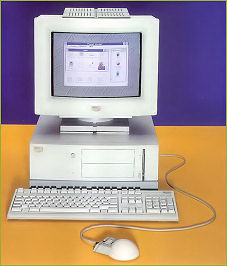 Ambra Hurdla 486 PC by ICPICompuServe proved slow and clumsy to use, especially on 14.4k dialup. In these formative years I looked at setting up our own electronics forum on CIS but the idea fell through. I eventually ditched CompuServe in favour of an upstart ISP in London called Demon Internet, who offered a “Tenner a month” (TAM or £10 a month) account for a raw Internet access. Arguably I was in the first 50,000 or so consumers in the UK to reach out onto the Internet. There were only a few hundred Demon Internet access phone lines available across the entire UK, 13 of them in my area. There was a 5% chance of connecting online through a local ‘Point of Presence’ (PoP) if the lines were all busy, and my modem would often redial a dozen or two times before connecting. My phone bill was 20+ pages long, full of 0845 dial-up sessions.
Ambra Hurdla 486 PC by ICPICompuServe proved slow and clumsy to use, especially on 14.4k dialup. In these formative years I looked at setting up our own electronics forum on CIS but the idea fell through. I eventually ditched CompuServe in favour of an upstart ISP in London called Demon Internet, who offered a “Tenner a month” (TAM or £10 a month) account for a raw Internet access. Arguably I was in the first 50,000 or so consumers in the UK to reach out onto the Internet. There were only a few hundred Demon Internet access phone lines available across the entire UK, 13 of them in my area. There was a 5% chance of connecting online through a local ‘Point of Presence’ (PoP) if the lines were all busy, and my modem would often redial a dozen or two times before connecting. My phone bill was 20+ pages long, full of 0845 dial-up sessions.
In those pre-web days, a Windows 3.1 PC like my Ambra Hurdla had no Internet capability, so users had to install a “winsock” and then some early Windows programs such as Pegasus Mail allowed Email to be handled. I spent a lot of time on Usenet (now Google Groups), using Demon’s KA9Q DOS-based mail and news program, to participate in sci.electronics newsgroups; it’s funny to look back and see my posts from 20 years ago, all that earnest work pickled online for ever. In 1995 I reviewed Demon’s new Email and Usenet program for Windows called Turnpike, which funnily enough is itself mentioned on Wikipedia.
I expanded my system with a second PC, a highly expensive Dell, which I networked to my Ambra Hurdla 486, so that if one went down I didn’t lose all my resources. I still work like that today. Gradually though, my PC and web-related activity superseded my hobby electronics interests, as I was no longer designing and writing up my own projects and rarely (if ever) built anyone else’s.
There were very few ISPs in the UK in those early days, but I visited a Southampton-based one called TCP Ltd. who set up an FTP server for us and I managed to publish EPE Magazine files and source codes online for free download. I recall mooching around in the server room. In 1996 I launched a very crude website for EPE Magazine, designed (if you could call it that) on my PC using Softquad Hot Metal Pro. The original efforts are still online here.
The 'Net - what's in it for you (and me)?
The world of web design, coding, ISPs, email and networking would then grab my attention for the next twenty years. At my instigation we bought the domain of (luckily) wimborne.co.uk and a web site URL of www.epemag.wimborne.co.uk slipped onto the October 1996 cover for the first time. My Basic Soldering Guide website was also set up on TCP’s servers at this time and that would become another key part in my portfolio, becoming a paperback and ebook in 2014. It was #1 in Google for many years.
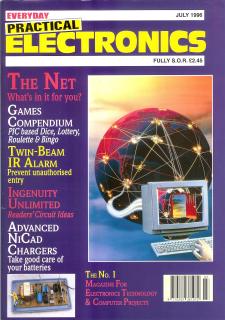 EPE July 1996 introduces the Internet to our readersIn July 1996 issue of EPE I wrote an article “The ‘net – what’s in it for you?” to explain to EPE readers that the Internet and world-wide web were heading our way. It would be a case of embrace it now or get run over in the stampede. A screenshot of Intel’s website was shown, and web users marvelled online at an actual moving image – an early example of an animated .gif. The issue also trailed Net Work – the Internet column, which started in August 1996, bringing readers the latest news and techniques used in this new branch of telecoms.
EPE July 1996 introduces the Internet to our readersIn July 1996 issue of EPE I wrote an article “The ‘net – what’s in it for you?” to explain to EPE readers that the Internet and world-wide web were heading our way. It would be a case of embrace it now or get run over in the stampede. A screenshot of Intel’s website was shown, and web users marvelled online at an actual moving image – an early example of an animated .gif. The issue also trailed Net Work – the Internet column, which started in August 1996, bringing readers the latest news and techniques used in this new branch of telecoms.
Net Work still runs to this day, describing networked technology that was completely unthinkable (led lightbulbs controlled by an app?) nearly 20 years ago when the sound of my 14.4k modem punctuated the air. Max Fidling, my pseudonym, described more antics in Ohm Sweet Ohm that month, not to mention Surgery and Ingenuity, and I did a rare product review on Electronic Principles 3.0 - a busy issue!
The July 1996 issue also had an Ingenuity Unlimited (readers’ own circuit ideas) that was spun back out of Circuit Surgery, when we apologised to both Elektor and Maplin for using circuits (May 1996 EPE) that actually belonged to them. (Contrary to what some people might expect, relations with Elektor are cordial, professional and friendly.) No less than four columns every month (five, if you include Ohm Sweet Ohm) meant that at one time I wrote or co-wrote a large part of EPE’s monthly editorial content for a while and business was very brisk. My Demon Internet address, which I still use to this day, was also the first Email address to appear regularly in EPE Magazine. There was a major buzz going on and life was novel, new and intensely exciting. What next in my world of electronics?
Teach-In 98
In between surfing the net and having cut my teeth on Teach-In ‘93, I sounded out the prospect of handling Teach-In 98, a series that ran from November 1997 to September 1998 offering an introduction to digital electronics and supporting the City & Guilds syllabus. Due to the volume of work, a team of lecturers from the University of Hull were roped in to help and this enjoyable series was co-written by Ian Bell, Rob Miles and Dr Tony Wilkinson with myself handling the practical “labs” starting with basic battery and bulb stuff; there was lots of solderless breadboarding and photography to do.
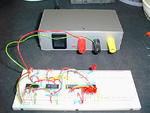 The original digital photo - Teach-In 98 PSU and breadboard experiment [click to see]The series got off to a very late start which caused some painful problems that are probably best forgotten. John Becker also scrapped my PSU design and insisted on using a PCB. The series was still well received, with Rob putting a witty spin on his version of electronics theory: he used armies of “shoppers” (“charge card carriers!”) jostling for bargains to describe electron flow, for example. Ian Bell would go on to inherit the Circuit Surgery column from me.
The original digital photo - Teach-In 98 PSU and breadboard experiment [click to see]The series got off to a very late start which caused some painful problems that are probably best forgotten. John Becker also scrapped my PSU design and insisted on using a PCB. The series was still well received, with Rob putting a witty spin on his version of electronics theory: he used armies of “shoppers” (“charge card carriers!”) jostling for bargains to describe electron flow, for example. Ian Bell would go on to inherit the Circuit Surgery column from me.
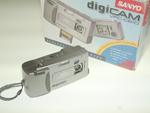 Sanyo VPC-G210 was an early 640 x 480px digicam used in a lot of my work [click to see]Talking of going digital, Teach-In 98 was also a milestone because digital photography was used for the first time in the practical labs, using a Sanyo VPC-G210 (640 x 480 px) VGA camera that cost a small fortune. The flexibility and vast increase in efficiency it offered was a real boon, and of course the results were instantaneous and photos could be re-taken if needed. This put my productivity light years ahead and my PC soon filled up with photos of my hands doing stuff with a solderless breadboard and a cheap yellow multimeter nearby. Smartmedia cards and a floppy-disk Smartmedia card reader were the order of the day: that or the serial port were the only ways to get images onto my PC. Teach-In 98 rolled ahead more or less on schedule but there were tense moments at times.
Sanyo VPC-G210 was an early 640 x 480px digicam used in a lot of my work [click to see]Talking of going digital, Teach-In 98 was also a milestone because digital photography was used for the first time in the practical labs, using a Sanyo VPC-G210 (640 x 480 px) VGA camera that cost a small fortune. The flexibility and vast increase in efficiency it offered was a real boon, and of course the results were instantaneous and photos could be re-taken if needed. This put my productivity light years ahead and my PC soon filled up with photos of my hands doing stuff with a solderless breadboard and a cheap yellow multimeter nearby. Smartmedia cards and a floppy-disk Smartmedia card reader were the order of the day: that or the serial port were the only ways to get images onto my PC. Teach-In 98 rolled ahead more or less on schedule but there were tense moments at times.
Thanks to my day job, some interesting tasks came my way, including interviewing Sir Clive Sinclair at the National Cycle Show, where he personally showed me around his new electric bicycle. I wrote about the Sinclair Zike and Zeta (Oct. 97 EPE). However I was so busy that I went full-time freelance in May 1998, and there would be several more electronic assignments heading my way to keep me very occupied.
Bebop to the Boolean Boogie
During these early years on the Internet, I bumped into Clive (call me “Max”) Maxfield in the Usenet sci.electronics newsgroup. Max was British but lived in the USA. His first foray into book authoring resulted in the 1995 title Bebop to the Boolean Boogie (An Unconventional Guide to Electronics Fundamentals, Components and Processes ISBN 1-878707-22-1), a brilliantly-written title that I felt was worthy of the EPE Direct Book Service, so we started selling Max’s book in the UK via mail order. Max’s breadth and depth of knowledge shone through, and the diagrams (drafted in Visio) were crystal clear. The title was adopted by Yale University for their introductory electronics course. Goodness, twenty years ago already!
Two years of hard slog on their part produced in 1997 a follow up Bebop BYTES Back (An Unconventional Guide to Computers) ISBN 0-9651934-0-3, co-written by Clive ‘Max’ Maxfield and Alvin Brown. It was a reference book with a big difference, as it had a Windows CDROM that hosted a fully-functional Internet-ready virtual computer: the Beboputer Computer Simulator.
The book walked readers through the evolution of computers, aided by interactive labs that ran in the Beboputer software – an entire computer simulator with hex and QWERTY keypads, displays and registers all on a Windows PC. Bebop BYTES Back started as it meant to go on, with the first chapter labelled ‘Chapter 0’ since computers start counting from zero. The book was an astonishing work, with brilliant illustrations and it contained a multitude of minutiae and nuggets that Max must have harvested in his own special nugget mine somewhere. All in all, Bebop BYTES Back was an unparalleled effort and one that Max and Alvin could be proud of.
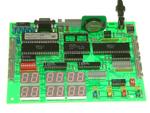 PhizzyB Physical Beboputer single board computer [click to see]
PhizzyB Physical Beboputer single board computer [click to see] Student Andrew Ayre (left) and lecturer Rob Miles at the University of Hull discussing the PhizzyB, 1998After introducing EPE’s readership to Max’s endeavours, I was asked to help in a new project called the PhizzyB, a “Physical” version of their on-screen Beboputer (i.e. PhizzyB was a real-life Physical Beboputer single board computer programmable from a PC). This was a very challenging assignment for a hobbyist magazine (and me!) because the Beboputer had been conceived in the USA as a PC program, not hardware. By this time, I was networking people together like crazy and met up with Max in the UK, with the result that the PhizzyB’s hardware implementation would be designed by a University of Hull student (Andrew Ayre). My role would be to bring the team together and then manage the subsequent PhizzyB magazine series in the UK.
Student Andrew Ayre (left) and lecturer Rob Miles at the University of Hull discussing the PhizzyB, 1998After introducing EPE’s readership to Max’s endeavours, I was asked to help in a new project called the PhizzyB, a “Physical” version of their on-screen Beboputer (i.e. PhizzyB was a real-life Physical Beboputer single board computer programmable from a PC). This was a very challenging assignment for a hobbyist magazine (and me!) because the Beboputer had been conceived in the USA as a PC program, not hardware. By this time, I was networking people together like crazy and met up with Max in the UK, with the result that the PhizzyB’s hardware implementation would be designed by a University of Hull student (Andrew Ayre). My role would be to bring the team together and then manage the subsequent PhizzyB magazine series in the UK.
Let’s Get Phizzycal
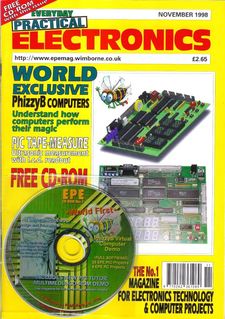 Nov. 98 EPE with its first cover CDROM featuring the PhizzyB [click to see]EPE would enjoy the world exclusive launch of the hardware PhizzyB and the PhizzyB Computer Simulator software, which accurate mimicked the hardware on-screen. The Simulator used a PBLink utility which communicated with a real-life PhizzyB through a serial port. Life got more challenging still: the material and demo labs would be written in the USA, and I would have to handle the sleeves-up construction side, acting as a guinea pig and general debugger. I would have to specify and source the components, build the labs and prove them, then handle the magazine write-ups, all to a strict monthly timetable.
Nov. 98 EPE with its first cover CDROM featuring the PhizzyB [click to see]EPE would enjoy the world exclusive launch of the hardware PhizzyB and the PhizzyB Computer Simulator software, which accurate mimicked the hardware on-screen. The Simulator used a PBLink utility which communicated with a real-life PhizzyB through a serial port. Life got more challenging still: the material and demo labs would be written in the USA, and I would have to handle the sleeves-up construction side, acting as a guinea pig and general debugger. I would have to specify and source the components, build the labs and prove them, then handle the magazine write-ups, all to a strict monthly timetable.
I sourced and supplied the PhizzyB pre-programmed EPROMs using Farnell’s device programming service. We found an Intel device that was compatible (other brands were not) and Farnell supplied and programmed them for us. I would test, label, number and package each PhizzyB controller ready for sale.
Life in my worklab was very busy and rewarding: these were indeed exciting times, with lots of bustle and many logistic and supply problems between the UK and USA were overcome before the PhizzyB design was eventually finalised and we went to press. The November 1998 issue of EPE proudly carried its first-ever cover-mounted CDROM with a demo copy of the PhizzyB Simulator, right at the start of my full-time freelance career. The Nov. 98 issue included my constructional article for the PhizzyB and my own sample board worked first time.
Over the Christmas break, though, we heard that one reader struggled to get his PhizzyB working and someone (ahem) kindly volunteered me to test and rebuild the reader's prototype, so I spent the Christmas break desoldering and resoldering his PhizzyB again (it worked).
In the same issue my Net Work column introduced the EPE Chat Zone forum which opened for the first time. It used Matt’s WWWBoard, a buggy free script which eventually got smashed by Russian hackers in 2005 and had to be replaced. A brand new concept of a downloadable edition of EPE was also announced. It was believed to be the first time anywhere that a printed magazine available on newsstands would also be available for download as a PDF.
Testing (PhizzyB) times
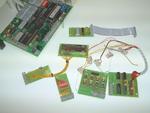 PhizzyB Labs were very tricky to build and write up [click to see]The practical PhizzyB labs proved to be tricky to handle. Most of our core readership had grown up with PCBs or stripboard, but the PhizzyB used a custom break-out board with point-to-point wiring that was very fiddly to deal with. It was not ideal and I worried that they were too intricate for a typical beginner, especially if they were not experienced at soldering. Never the less, each lab worked perfectly thanks to Max’s designs and I generally found neat ways of presenting the PhizzyB hardware experiments. I earned every penny of my royalties though.
PhizzyB Labs were very tricky to build and write up [click to see]The practical PhizzyB labs proved to be tricky to handle. Most of our core readership had grown up with PCBs or stripboard, but the PhizzyB used a custom break-out board with point-to-point wiring that was very fiddly to deal with. It was not ideal and I worried that they were too intricate for a typical beginner, especially if they were not experienced at soldering. Never the less, each lab worked perfectly thanks to Max’s designs and I generally found neat ways of presenting the PhizzyB hardware experiments. I earned every penny of my royalties though.
As the magazine series unfolded, Max did some pretty cool stuff with the PhizzyB, including the idea of mobilising the PhizzyBot with some gearmotors and extra-long microswitches as ‘feelers’ and finally an l.d.r. array that attracted the PhizzyBot towards a beam of light. Again my job was to specify and source all the hardware on the UK side and sort out the experiments using Max’s ideas. I made a plastic chassis with gearmotors, then an array of ORP12-type ld.r.s sandwiched between two AOL cover disks, glued onto some plastic plumbing pipe! It worked brilliantly.
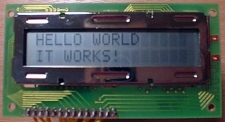 PhizzyB LCD
PhizzyB LCD
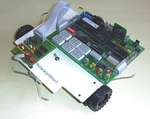 PhizzyBot buggy with 'feeler' microswitches
PhizzyBot buggy with 'feeler' microswitches
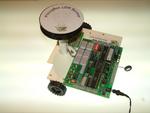 PhizzyBot mobile buggy with 6-way LDR sensor
PhizzyBot mobile buggy with 6-way LDR sensor
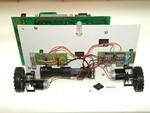 PhizzyBot underside with battery pack, gearmotors and control boards [click to see]The PhizzyBot was programmed through the PBLink lead connected to my latest acquisition, a £2,000 Dell 350 MHz desktop PC I dubbed ‘The Beast’ because it was a total pig at times. Dell somehow heard that I worked for a technical magazine and dedicated an engineer to two days’ worth of onsite work fixing it. Hard to think that would happen today.
PhizzyBot underside with battery pack, gearmotors and control boards [click to see]The PhizzyBot was programmed through the PBLink lead connected to my latest acquisition, a £2,000 Dell 350 MHz desktop PC I dubbed ‘The Beast’ because it was a total pig at times. Dell somehow heard that I worked for a technical magazine and dedicated an engineer to two days’ worth of onsite work fixing it. Hard to think that would happen today.
My other role in all this was to submit everything for publication per the timetable. Again the new digital camera played a huge part in speeding the production cycle and without it the series would never have been possible. From the tricky discussions I had with EPE’s typesetter, I believe my colour PhizzyB photo was the first colour digital image to appear on a cover a bit later, thanks to the Sanyo digicam used for photographing every experiment. The typesetter understood inches and flatbed scanners, and hated the idea of pixels. Selling the idea of digital photography was a struggle! Over the years I upgraded to a Ricoh digicam, then another, and then a Fujifilm bridge camera, and wasted a lot of money on early digital cameras.
The PhizzyB series ran from Nov. 98 to July 99 issue and won many followers. At that time the PhizzyB was a complete blast and I had the busiest time of my life, all brought about by an accidental meeting on Usenet in the evolutionary era of the 1990’s Internet.
Power Generation From Pipelines To Pylons
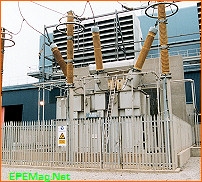 400kV transformers (c) AWMy next project was the two-part series From Pipelines to Pylons (Everyday with Practical Electronics, August and September 1999), a highly ambitious project that described the generation of electricity from the gas turbine all the way through to the domestic wall socket. It was something that I had always wanted to do, and I was thrilled to gain entry to a gas-fired power station which was in shutdown mode, so I had unfettered access across the entire site for weeks and I set about unpicking the world of a CCGT power station, the 400kV supergrid network, three phase supplies and the principles of grounding.
400kV transformers (c) AWMy next project was the two-part series From Pipelines to Pylons (Everyday with Practical Electronics, August and September 1999), a highly ambitious project that described the generation of electricity from the gas turbine all the way through to the domestic wall socket. It was something that I had always wanted to do, and I was thrilled to gain entry to a gas-fired power station which was in shutdown mode, so I had unfettered access across the entire site for weeks and I set about unpicking the world of a CCGT power station, the 400kV supergrid network, three phase supplies and the principles of grounding.
On one visit to the power station I took some photos, and I was invited up onto an overhead mesh gantry to take an aerial view of the turbine gallery. My guide shot up the ladder like a rat up a drainpipe, and I followed. It must have been 30-40’ up in the air at least, so I clambered gingerly up a vertical ladder and I was pretty terrified (I hate heights); see-through mesh gantries make me dizzy anyway and I stumbled out onto the overhead gantry with my head spinning. Never the less it was really fascinating and I managed to get some exclusive photos looking down onto the turbines that are still referenced today by various education authorities.
More recently I reproduced the series and web-enabled it on www.epemag.net
Teach-In 2002
With my project-building days behind me, the web site side of things grabbed my attention and EPE’s Internet presence continued to evolve. However, after cutting my teeth on Teach-In 93 and Teach-In 98 maybe there was scope to squeeze out one more Teach-In series, I thought. The Year 2000 came and went, with Y2K bugs being a global non-event, and as the next Teach-In 2000 was spoken for (Tech. Ed. John Becker would write it) I pitched for writing Teach-In 2002 instead.
This time I would be joined by Ian Bell again and Dr. Dave Chesmore, then a lecturer at the University of Hull. I asked them for ideas and they proposed that Teach-In 2002 (Making Sense of the Real World) could cover environmental sensors, instrumentation amplifiers and other material not covered before in our pages. Dave was extremely skilled and highly knowledgeable in this area and they handled the theory side while I was again a guinea pig for their experiments, also writing up the practical labs and doing the digital photography.
In the event, production got off to a poor start. Suffice to say that life became extremely tense at the start but we got the series back on track in the nick of time. Memorably, John Becker commented that some of Teach-In 2002 seemed overly complicated to him, until we pointed out that his PIC microcontroller projects were very complicated too! Teach-In 2002 was a high-quality series that gained some fans – a rain alarm that used a piezo disc to detect rain drops! – but I guess the sustained pressure and tension of my workload finally took their toll and my outlook on work was never the same again.
My From Pipelines to Pylons and Teach-In 2002 were the last major editorial projects that I was involved with (until the 50th Golden Anniversary item in 2014), and my attention was diverted to online developments instead and my own business interests kept me very busy. I more than keep my hand in at EPE though because, as much as anything, this would enable me to produce a variety of cover-mounted disks for EPE, Teach-In, the Modern Electronics Manual and others, all based on HTML or PDFs. And of course there was Net Work to write.
EPE Online then came along (hosted in the USA at epemag3.com) and that used bespoke programming, a subscriber database and PDF delivery on the fly, which put Max and Alvin in the hot seat for a number of years. I handled the website maintenance using Joomla CMS, which was pretty hateful compared with what I was used to. Thus two distinct sectors opened up, the USA side (EPE Online and electronic subscriptions) and the UK side, producing the magazine and handling printed copies. I also handled the EPE shopping cart, hopefully being updated in 2015.
Long story short, the recession then bit hard and for some well documented reasons eventually EPE would consolidate itself and partner with Australia’s Silicon Chip, and I had to migrate the entire US website back to the UK at the end of 2012. It was not a ‘given’ that I would still have a job, but in the event I built static websites for EPE and Radio Bygones that are still running to this day. More recently I have diversified into book authoring, with my Basic Soldering Guide Handbook sponsored by Antex (the brand of soldering iron I used continually as a hobbyist since I started out as a schoolboy) which sells well across the USA and UK on Amazon. Hard to believe, books printed individually on demand and shipped worldwide, all thanks to the Internet.
A Golden Anniversary
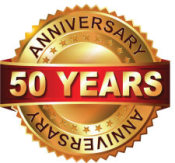 I was very proud to write the EPE 50th Anniversary features in November and December 2014. The articles took several years, on and off, to plan and were well received. If you want to read the story of Britain’s Practical Electronics and Everyday Electronics over the past half century, it’s the place to go.
I was very proud to write the EPE 50th Anniversary features in November and December 2014. The articles took several years, on and off, to plan and were well received. If you want to read the story of Britain’s Practical Electronics and Everyday Electronics over the past half century, it’s the place to go.
It explains how the entire hobby has evolved, changed and re-invented itself since the early years, from basic discrete transistor and TTL/ CMOS logic circuits up to the modern microcontroller projects that appear today, shaped and helped by the late John Becker who worked tirelessly on his projects or supporting EPE readers. Even though the projects are now produced in Australia and are more advanced than ever before, EPE still has much home-grown content on offer that you won’t find anywhere else.
Britain is very lucky to still have a UK hobby electronics magazine when almost every other title in the West has closed down; Australia and the USA have not been immune from market forces but EPE has adapted with the times. I’m pleased to have played a part in entertaining readers, from my early schoolboy Ingenuity Unlimited efforts in the mid 1970s, through my own constructional projects, various regular columns and then various Teach-In series, that I hope have helped others to take their first steps in marvelling, understanding and applying microelectronics just like I did when I embarked on my "voyage on Veroboard".
Today it’s the web and regular columns that keep me pretty busy, but with retirement a little way away yet, God willing, I’m sure the time will come when I can once again relax, warm up my Antex soldering iron and indulge in my hobby once again. I will start by restoring my old constructional projects, some now dating back forty years to when I was a 1970’s teenager who took over his Dad’s garage and caught the electronics bug for the very first time.

- An index page of all my constructional projects and notes is at http://www.alanwinstanley.com/hobby-electronics/2015/4/30/library-of-constructional-projects-and-reprints-alan-winstan.html
- I'll write up more on the Sanyo VPC-G210 digicam separately.
 CCGT,
CCGT,  PhizzyB,
PhizzyB,  electricity generation
electricity generation 
Reader Comments (3)
> The issue also trailed Net Work
Should that be _trialled_ ?
TREV.
> I would have to specific and source the
Perhaps _specify_ ?
TREV.
Trev,
Yes to specific, thanks for pointing that out. Now specify. Trailed is correct (the jury's out on whether it's double L) as it means to promote something, eg a forthcoming TV series or a magazine column :) So I trailed Net Work. Thanks for reading and I hope you found something of interest. AW